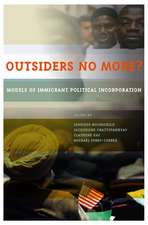Migration and Residential Mobility: Macro and Micro Approaches
Autor Martin Cadwalladeren Limba Engleză Paperback – 14 feb 1993
Designed both as a text for courses in population geography and migration and as a resource for planners working on migration issues, Migration and Residential Mobility studies the movement of people from region to region and within cities in such developed countries as the United States, Canada, England, and Sweden.
Martin Cadwallader presents the major theoretical and empirical issues of the field, while describing and explaining various kinds of statistical models for migration. In particular, he uses structural equation models to specify the interrelations of variables that affect migration. He draws together concepts and methods from geography, economics, sociology, demography, and other fields, but provides a unifying geographical emphasis on the relationships among socioeconomic processes and spatial patterns.
The book covers both macro and micro approaches to migration. The macro approach explains broad patterns of migration by measuring characteristics of the socioeconomic and physical environments, while the micro approach explains why individual people move, using a model of psychological decision-making processes. Cadwallader also makes a distinction between interregional migration and residential mobility within cities.
Martin Cadwallader presents the major theoretical and empirical issues of the field, while describing and explaining various kinds of statistical models for migration. In particular, he uses structural equation models to specify the interrelations of variables that affect migration. He draws together concepts and methods from geography, economics, sociology, demography, and other fields, but provides a unifying geographical emphasis on the relationships among socioeconomic processes and spatial patterns.
The book covers both macro and micro approaches to migration. The macro approach explains broad patterns of migration by measuring characteristics of the socioeconomic and physical environments, while the micro approach explains why individual people move, using a model of psychological decision-making processes. Cadwallader also makes a distinction between interregional migration and residential mobility within cities.
Preț: 164.14 lei
Nou
Puncte Express: 246
Preț estimativ în valută:
31.41€ • 34.22$ • 26.47£
31.41€ • 34.22$ • 26.47£
Carte tipărită la comandă
Livrare economică 23 aprilie-07 mai
Preluare comenzi: 021 569.72.76
Specificații
ISBN-13: 9780299134945
ISBN-10: 0299134946
Pagini: 293
Dimensiuni: 152 x 229 x 18 mm
Greutate: 0.4 kg
Ediția:New.
Editura: University of Wisconsin Press
Colecția University of Wisconsin Press
ISBN-10: 0299134946
Pagini: 293
Dimensiuni: 152 x 229 x 18 mm
Greutate: 0.4 kg
Ediția:New.
Editura: University of Wisconsin Press
Colecția University of Wisconsin Press
Recenzii
“Migration and Residential Mobility is a tour de force within the field of migration representing an excellent summary of Martin Cadwallader’s research on migration over the past seventeen years. The book will establish and confirm him as a leading authority within the field.”—James O. Huff, University of Illinois
Notă biografică
Martin Cadwallader is professor of geography and dean of the graduate school at the University of Wisconsin–Madison. He is the author of Analytical Urban Geography: Spatial Patterns and Theories.
Descriere
Designed both as a text for courses in population geography and migration and as a resource for planners working on migration issues, Migration and Residential Mobility studies the movement of people from region to region and within cities in such developed countries as the United States, Canada, England, and Sweden.
Martin Cadwallader presents the major theoretical and empirical issues of the field, while describing and explaining various kinds of statistical models for migration. In particular, he uses structural equation models to specify the interrelations of variables that affect migration. He draws together concepts and methods from geography, economics, sociology, demography, and other fields, but provides a unifying geographical emphasis on the relationships among socioeconomic processes and spatial patterns.
The book covers both macro and micro approaches to migration. The macro approach explains broad patterns of migration by measuring characteristics of the socioeconomic and physical environments, while the micro approach explains why individual people move, using a model of psychological decision-making processes. Cadwallader also makes a distinction between interregional migration and residential mobility within cities.
Martin Cadwallader presents the major theoretical and empirical issues of the field, while describing and explaining various kinds of statistical models for migration. In particular, he uses structural equation models to specify the interrelations of variables that affect migration. He draws together concepts and methods from geography, economics, sociology, demography, and other fields, but provides a unifying geographical emphasis on the relationships among socioeconomic processes and spatial patterns.
The book covers both macro and micro approaches to migration. The macro approach explains broad patterns of migration by measuring characteristics of the socioeconomic and physical environments, while the micro approach explains why individual people move, using a model of psychological decision-making processes. Cadwallader also makes a distinction between interregional migration and residential mobility within cities.






